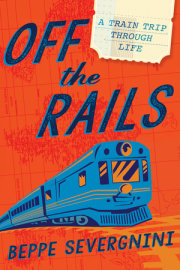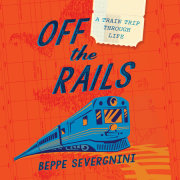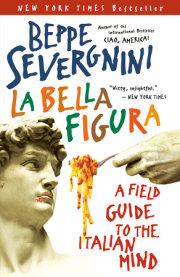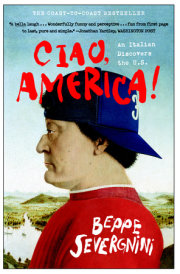1
From Washington to Washington: With Antonio Across America
I haven't been carrying him at all. He's been carrying me!
Robert M. Pirsig, Zen and the Art of Motorcycle Maintenance
The Europeans Don't Live Here Anymore
The house is made of wood, painted white, and looks west. The front door is black, with a carved fan decoration above it, and there are three windows with the shutters nailed to the facade, on the off chance that some modest European might have the impulse to shut them at night.
But there's no danger of that now. The Europeans don't live here anymore.
In 1994 and 1995, I lived here with my wife, Ortensia, and my son, Antonio, aged two. I was the only foreign correspondent for a brand-new Italian newspaper, La Voce, and I was based in Washington, DC. My official title was "bureau chief," but to be honest, there was no bureau. I worked from home in Georgetown. It was a gracious part of America, full of talkative ladies and hyperactive dogs. Bill Clinton was in the White House-Monica Lewinsky, too, as it turned out-but politics was not the first topic of conversation. My neighbors talked mostly about the renovation of Volta Park and told me how to maintain tree boxes properly-they suspected that, as a newcomer, I'd be inattentive and possibly sloppy.
We left one morning in May 1995, after holding a yard sale that amused the neighbors and loading a moving truck that angered the wife of the senator from Montana. ("Move that truck! I'm married to the senator from Montana!") The truck carried away what was left of our furnishings, to be packed into a wooden crate and shipped to our house in Crema, Italy. Once it had been emptied and painted green, ventilated with a door and windows, and roofed with terra-cotta tiles, the crate went to live at the far end of the backyard, in the shade of the oak and the plane trees. A perfect playhouse.
But the two-year-old boy has now turned twenty; he'd be embarrassed to take his girlfriend into the playhouse, even if we, his parents, would find it romantic. The crate from our move back is baked by sun and drenched by rain. I tell Antonio these things, but he ignores me. He's looking at the American house where he was a toddler, amused rather than moved. "I remembered it as being bigger," he says, forgetting that back then he was smaller.
An evening in June, green leaves and blue sky: this time of year, Georgetown is at its best. We try to reenact a photograph snapped right here in 1995, on the sidewalk in front of the house: Papˆ kneeling, Antonio standing with a soccer ball in his hands. The difference is that, back then, even on my knees, I was still taller than he was; now I'm hip-high next to him. The new owners, Griff and Kathleen Jenkins, watch us with smiles on their faces. Griff busies himself with a pair of shears, enthusiastically trimming up and down the street, to make sure that no branches interfere with the Italians' photography.
We've become friends over the years. The Jenkins family-father, mother, two teenage girls-cheerfully tolerated the stream of readers who came to see the house they'd read about. To reassure visitors they had the right place, and dissuade them from ringing the doorbell, they fastened a small bronze plaque to the door, engraved with the title of the book that tells the story of our lives behind those windows: Ciao, America!: An Italian Discovers the U.S.
Antonio laughs. "Congratulations! I thought you had to be dead to get a bronze plaque."
The white wooden house on Thirty-fourth Street NW-a one-way street running downhill, then and now-has been renovated, but not beyond recognition. The ground floor, where we played soccer on the hardwood floors, using the fireplace as our goalpost, is still bright and sunny. The downstairs, with the kitchen and dining room, still resembles a fallout shelter: badly lit, sparsely furnished. We step out the back door into the yard. Everything looks familiar. The tree with white blossoms is where it ought to be, the magnolia still showers leaves into the neighbors' yard, and the cement cherub is still making his way through the rosebushes. It did its best-of that I feel sure-but in twenty years it still hasn't managed to become an antique. Older, perhaps, but not necessarily wiser. Much like us, much like America, which it's now time for us to go check up on. The plan is to travel from Washington, DC, to Washington State, by the southern route. By train, though not without variations. An American curve five thousand miles long, running through Atlanta, New Orleans, Dallas, Flagstaff, Tucson, San Diego, Los Angeles, and San Francisco. Destination: Seattle. A trip with my son, to discover the joy of letting him make the decisions. He always has, truth be told, but now it's official. Because there's no two ways about it: Antonio knows what he wants. For instance, here's one condition he insisted on: we have to spend at least two days in Washington, DC, at a certain hotel near Dupont Circle. Ostensibly, to recover from his transatlantic flight and jet lag. Actually, though, because he wants to eat breakfast in the room, and he knows that he can forget about that luxury on an Amtrak train.
Washington, DC, is a green, geometric misunderstanding that brings together American and foreign tourists. Fifteen million of them every year. They arrive expecting to find a monumental, transitory, artificial city, built by politicians for politics, cut off from the rest of the country. Which is nonsense. Washington, DC, is more representative of America than New York or Los Angeles, which are both unique and irreproducible. ThereÕs only one White House, but there are lots and lots of white houses just like ours. TheyÕre as lively as they are numerous. To a fault, in some cases.
Washington is a mixed-up, fanciful city, muggy in the summer, freezing in the winter, magical in springtime, brisk in the fall. A strange city: a center of power that has very little of its own. The city is not represented in Congress, which irritates the residents, seeing that they pay taxes, like all other Americans. The license plates carry the somewhat contentious motto "Taxation without representation," a variation on the slogan of the American Revolution ("No taxation without representation"). The colonists, in the middle of the eighteenth century, were protesting the fact that they were obliged to pay taxes to London but had no say in parliamentary decisions. The residents at the turn of the twenty-first century are objecting because they are obliged to pay federal taxes, and they have no say in Congress. Washington is a border city: it's the South of the North, and the North of the South. A city where whites are in the minority, where plants grow luxuriantly, and where many houses have a porch. The classic WPA guides-a series of guidebooks to the American states, published between 1937 and 1945, under the auspices of the Federal Writers' Project-informed visitors: "Everywhere in the Capital one hears the indolent cadence of Southern speech, and encounters that admirable though often irritating Southern characteristic-the innate aversion to hurry and worry."
Well, that's not the way it is anymore. For many years now, the nation's capital has been an anxious, brusque, and formal place, like the rest of America's cities when it comes to work. Even on a day like today. The heat is ferocious, the humidity oppressive. Antonio looks at me and says nothing, but he drags his feet as if to ask, "Where on earth have you brought me?" Beneath a sky the color of dirty glass, men in ties and women in skirt suits dart back and forth like pinballs: they're trying to run up as many points as they can before vanishing into some quiet building. Ideally, with air-conditioning, something pinball machines don't have.
Driven by a combination of suffocation and civic duty, we visit the Newseum, where America tells its story as it likes to hear it: heroic and true to its values, with the occasional touch of enthusiastic madness. We walk past FBI headquarters. To decorate the temporary wooden barriers around the renovation work, they're using famous sayings of the presidents: in chronological order, playing no favorites. We climb up to Capitol Hill, we walk down to the Mall, and, exhausted, we suddenly remember what we ought to have known, since we've lived here before: in America no one goes for a stroll; they go somewhere and come back.
We hide out at Charlie Palmer's, a steak house that's popular with members of Congress. An austere place that could be mistaken for a hospital if it weren't for the color: mahogany instead of pale green. Antonio-sweat drenched, sleepy, and argumentative-wants a hamburger with fries. The uniformed headwaiter looks down his nose at him, the way a Venetian gondolier might look at a Realtor from Richmond, Virginia, as he snaps pictures on the Grand Canal. I look at the headwaiter. I explain to him that, in any tussle with the appetite of a jet-lagged twenty-year-old, he's bound to lose. He smiles and comes back with the hamburger.
We grab a taxi, we head for Dupont Circle, and we get stuck in traffic caused by the Pride Parade. The situation meets with the Somali taxi driver's disapproval, and he breaks off the intense conversation he's carrying on over his cell phone to curse the parade in an unidentifiable language. Antonio, suddenly wide-awake, starts asking me a series of difficult questions.
"Why are the streets full of half-naked people, but it's considered scandalous to show a breast on television? Do you remember that time at the Super Bowl?"
"What does Dykes on Bikes mean?"
"Why is DC Eagle wearing nothing but a black leather miniskirt?"
"Why is that priest in the march?"
And then, back at the hotel:
"Why did that guy in thermal underwear on the elevator offer us free condoms, but I'm still not old enough to order a beer?"
Coward that I am, I suggest he ask the coffee shop waitress, who looks to be about his age; but Antonio, lying in his turn, claims that his English isn't up to the task. But the young woman is talkative. She tells us that the Gay Pride Parade snarls traffic and brings in plenty of customers; her salary basically goes to pay taxes, seven hundred dollars every two weeks. She makes her money off tips. With foreigners, it's best to be direct, she tells us; they don't always know it's customary to leave a tip, and if the tip is generous, all the better. She doesn't seem particularly interested in the world around her, nor do the Americans in the restaurant seem particularly interested in her.
We leave, go into Kramerbooks to buy a Rand McNally road atlas, then walk down Sixteenth Street-the street that once separated the world of the whites from everyone else-to Pennsylvania Avenue. Outdoor cafŽ tables, bicycles leaning against walls, people chatting. Washington, DC, seems to have figured out what it had forgotten twenty years ago: there's no law against slowing down, no regulation forbidding you to stop and chat with your friends on the street.
Union Station has changed since 1995. The American love of strict procedure hasnÕt, though. We all have to wait in one place; we all have to enter the gate at the same time, then wait our turn to be taken to the faraway track in an electric vehicle. The driver, dressed in a scarlet uniform-age impossible to guess, and with an inexplicable enthusiasm-drives and shouts as if he were competing in a rodeo. He drops us off at Track J25, train no. 19, destination New Orleans. He wishes us happy travels, eager to reprise his show for the next passengers. We take possession of our compartment, which is a concentrate of American mechanical fantasies: a sink that folds away and becomes a step, for instance. We need to find a place to put everything. WeÕll be spending a little more than twenty-four hours in this compartment, but we canÕt spend that time with the wheels of our roller suitcases on our necks. I show Antonio my copy of Travels with Charley, by John Steinbeck, which I brought with me from Italy. I open the book, find the page, and read aloud:
When I laid the ground plan of my journey, there were definite questions to which I wanted matching answers. It didn't seem to me that they were impossible questions. I suppose they could all be lumped into the single question: "What are Americans like today?"
Antonio replies: "Well, they're shorter than we are, that's for sure. At least, the ones who travel by train must be, because I'm too tall to fit in this bunk."
"Any other comments?" I ask.
He looks at the cover of the book. "Your author traveled with a dog, who barked or wagged his tail to make himself understood. I am your son, and I'd like to inform you that you're sitting on my backpack."
I have a suspicion that the boy's not going to read the book, but he's already commented on it. When he grows up, he could be a book critic. Time to go.
Night Train for New Orleans
Our train is called the Crescent, and it left Manhattan's Penn Station at 2:15 in the afternoon. It stopped, ninety-one miles later, in Philadelphia; it pulled out again at 3:55. Ninety-four miles later it arrived in Baltimore, which it left at 5:14 p.m. After forty miles it pulled into Union Station in Washington, DC, and left again at 6:30, with two Italians aboard. An older one, euphoric. And a younger one, puzzled.
The train is supposed to reach Charlotte, North Carolina, tonight at 2:20 a.m. Atlanta, Georgia, tomorrow morning at 8:13. Birmingham, Alabama, at 10:23. And then, finally, New Orleans. Arrival scheduled at 7:32 p.m., 1,377 miles from its starting point. I'm certain of the schedules and the distances because Amtrak has salted the train cars with brochures providing all this information about the trip. The national love of numbers has been satisfied; the love of comfort-another national commandment-a little less so. Amtrak represents the side of America that is practical and unshowy; not the highly efficient, innovative, and aesthetically impeccable America. The only thing our train has in common with an Apple product is the color: the gleaming silver that is reminiscent of Airstream trailers and diner counters. These are places where the nation likes to see its reflection, and remember the way things were. There are three Scenic Highlights touted to the passengers:
vibrant Northeast cityscapes (that is, the train is going to run through the ramshackle outskirts of several large cities)
Copyright © 2019 by Beppe Severgnini. All rights reserved. No part of this excerpt may be reproduced or reprinted without permission in writing from the publisher.











